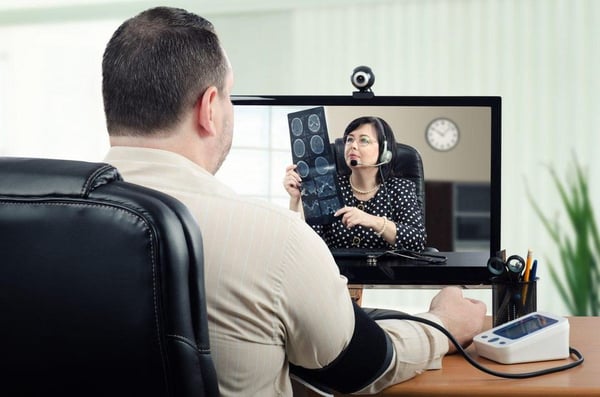Everyone knows about SARS-CoV-2, more commonly known as the Coronavirus of 2019 (abbreviated COVID-19). This new virus is spreading at an alarming rate, and the CDC recently stated that "current circumstances suggest it is likely that this virus will cause a pandemic." Healthcare facilities need to find a unique solution to stop the spread of this virus. Could the answer be as simple as a headset?

What is COVID-19, and how is it spread?
COVID-19 is a respiratory disease that originated in China and is now in many countries, including the United States.
Common symptoms mimic those of the flu, such as fever, cough, and shortness of breath/trouble breathing. Symptoms may appear 2-14 days after exposure to COVID-19.
The virus is most commonly spread from person to person via infectious secretions (sputum, serum, blood, respiratory droplets, etc.), usually passed with close contact. This means that staff members may be affected when treating a patient, so it is essential to wear face masks, eyewear, gloves, and gowns, and to wash hands thoroughly after disposing of the protective gear.
How is it affecting hospitals and other healthcare facilities?
COVID-19 is an infectious virus that is quickly spread. As such, it has to be contained. This means that patients need to be quarantined until the virus has run its course, which is upwards of 14 days. The consensus is that patients that are exhibiting signs must be put into Airborne Infection Isolation Rooms (AIIR) until they get better. While in theory, this sounds simple, hospitals are quickly running into problems.
First, many hospitals (especially rural ones) don't have AIIR in their facilities. When initially designing their campus, the probability of needing these units was likely very low. Further, if hospitals do have AIIR on their campus, they are likely to run out of room. This leaves the staff with deciding where to place the patients and how to manage the supply of essential medical devices and personal protective equipment (PPE). It is important to note that having a real-time locating system in place is essential - especially in moments of crisis - for efficient asset management.
Second, PPEs are in high demand and are becoming harder to get access to. With global supplies already depleted from the outbreak and manufacturers facing a massive increase in new orders, some hospitals in the US have been unable to get new shipments of N95 masks. There have also been documented cases where respirators and other essential protective equipment have been stolen in high-traffic areas like lobbies and waiting rooms. This is just the beginning. Pandemics tend to cause panic, which results in unpredictable behaviors and overall chaos.
Finally, COVID-19 isn't completely understood, so healthcare officials are making treatment regimens that are based on educated guesses and isolation. While trial and error is typically the way we handle responding to new illnesses, if a patient is released too early and is still contagious, it can cause more harm than good. This scenario may not be pressing yet, but if this pandemic gets worse and healthcare facilities are stressed about space and resources, patient management gets even more challenging and mistakes may happen.
We need a solution that looks outside the box. We need to consider telemedicine.
What is Telemedicine?
Telemedicine is defined as "the remote delivery of healthcare services." There are two main ways of delivering this care: hub-and-spoke or direct-to-consumer.
- Hub-and-spoke: This is the more common method. This method incorporates face-to-face video-conferencing with a patient and their doctor or nurse to other healthcare staff. After an initial physical and diagnosis by the doctor or nurse, they video-conference staff that may have more insight and experience and together discuss the next steps and possible treatments. By scheduling meetings with specialists anywhere in the world, the patient is getting the best possible care, even if the doctor and patient are hundreds of miles apart.
- Direct-to-consumer: This up-and-coming method is when the patient is in their home, and they do a self-physical while following the directions of a specialist via technology. Then, the healthcare staff can advise the patient remotely, giving expert advice and help, without needing to be in person. This method is especially important to note with airborne, contagious viruses and other infectious diseases that are easily transmittable. If the staff isn't physically there, there is no way to risk exposure. Further, by staying in their house, the patient is isolating themselves from the outside world, which is containing the virus and stopping the spread before it happens.
How does telemedicine help to contain the spread of COVID-19?
When dealing with the coronavirus, the idea of having a complete virtual clinic solution is ideal. California and New York have been hit the hardest by the virus so far. As such, the doctors and healthcare staff with the most experience are in these areas. When cases come up in less affected areas, there needs to be an ability to connect with those who have first-hand experience with the virus, to give the best possible diagnosis of the patient.
Ideally, the direct-to-consumer option of telemedicine is the right choice. Often, COVID-19 presents itself as the flu. Most people who have the flu don't need to go to the doctor and are able to fight it at home. This is the same case for this virus. If only extreme cases go to hospitals, then it is likely for AIIR to be available, and it keeps hospitals from being overcrowded, keeps the overall panic low, and ultimately prevents the spread. To implement this, the healthcare facility needs a video conference communication software and a proper headset.
Video conferencing tools can be simple or complex, dependent on the capabilities of the healthcare facility. One of the most often overlooked elements of this solution is the headset that the doctor is using.
Why are we talking about a headset in healthcare?
In a busy, ever-moving environment, there are security risks, sensitive equipment, noise and distractions all around. Everyone is in constant movement, each juggling their own daily tasks. The headset is what creates the atmosphere for an innovative solution such as telemedicine to follow.
Your headset must:
- Be HIPAA Compliant - This means that no data is to be stored on these devices.
- Have Digital Security - Basically, it cannot be hacked in any way. You're dealing with sensitive information.
- Not interfere with other sensitive equipment - Staff is surrounded by sensitive medical equipment that cannot be compromised. Your headset needs to utilize Bluetooth frequencies that will not interfere.
- Have Noise-Cancellation - When you're conferencing with a patient or another staff member, they should have your full attention; a life might be at stake. Your headset should drown-out the noisy environment around you, allowing you to focus your attention and expertise where it is needed most.
Partnered with Jabra, we can offer healthcare officials cutting-edge headsets designed with telemedicine in mind. Check out this downloadable spec sheet to choose which headset is best suited to act as your weapon against COVID-19, and let's stop the spread of the virus together!




